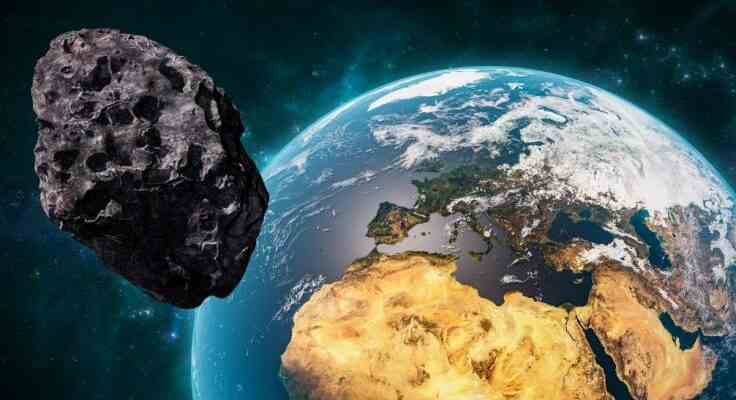“(2022 GL1)” comes closest to us! A total of 11 near-Earth asteroids reach the closest point in their orbit today. An overview of the largest asteroids near Earth on May 23, 2022.
Which asteroids are near Earth today?
Image: Adobe Stock / Matthieu
NASA is currently aware of over 1.1 million asteroids in the solar system. Thousands more are discovered every month. Special attention is paid to the so-called near-Earth asteroids, which do not move around the sun like most asteroids in the asteroid belt, but come close to the Earth’s orbit and can therefore also be dangerous to our home planet. This article gives you an overview of all the near-Earth asteroids that are passing the closest point in their orbit today.
On Monday, May 23rd, 2022, a total of 11 asteroids will reach their closest station during the day.
The largest near-Earth asteroids today
“(2008 week 2)” is currently the largest with an estimated diameter of 305 to 682 meters asteroid near earth. “(2008 KW2)” reaches its next approach to earth today at 10.01 a.m. The second largest near-Earth asteroid is “488580 (2002 GK8)” and has an estimated diameter of 305 to 682 meters. “(2020 VY3)” today ranks 3rd among the largest near-Earth asteroids (97 m – 216 m).
This asteroid is coming particularly close to Earth today
The closest thing to Earth today is the asteroid “(2022 GL1)”. It approaches our planet at 09:55 a.m. at a distance of up to 14.3 million km.
The asteroid that has come closest to us so far without impacting Earth was “(2020 QG)”. On August 16, 2020, it flew past Earth at a speed of around 44,000 km/h, just 3,000 km away. Coming from the direction of the sun, experts didn’t see it coming: it was only spotted 6 hours after its flyby. It would probably not have caused much damage on Earth even if it had collided. Because of its small size, only 3 to 6 m in diameter, it is assumed that it would have burned up in the atmosphere if it had come closer.
Potentially dangerous asteroids
Potentially dangerous asteroids are those asteroids that come closer than 0.05 AU (approx. 7.5 million km) and have an absolute brightness of 22 mag or less. They are therefore considered large enough (at least around 140 m in diameter) to cause considerable damage in the event of a collision. About 20 percent of near-Earth asteroids are classified as potentially dangerous.
There are no potentially dangerous asteroids near Earth today.
9 Earth orbit cruisers near Earth
Asteroids that cross the orbit of the earth are also called orbit cruisers. Near-Earth type asteroids Apollo cross Earth’s orbit from outside, near-Earth type asteroids Aten cross the earth’s orbit from within. Today a total of 9 Earth orbit cruisers are approaching our planet.
Near-Earth Apollo asteroids today: “(2008 KW2)”, “(2014 JT2)”, “(2017 SF20)”, “(2019 YN)”, “(2021 BD3)”, “(2022 GL1)”
Near Earth Aten asteroids today: “(2000 HO40)”, “(2018 KD2)”, “(2018 NR1)”
Amor and Atira type asteroids do not cross Earth’s orbit. While the hard-to-discover Atira-Asteroids move completely within Earth’s orbit, approaching type asteroids cupid the earth’s orbit from the outside.
- near-Earth Amor asteroids today: “488580 (2002 GK8)”, “(2020 VY3)”
All near-Earth asteroids today at a glance
| Surname | distance | size | speed | Type | Appointment close to earth |
|---|---|---|---|---|---|
| (2022 GL1) | 14.3 million km | 30 – 68 m | 15838km/h | Apollo | 05/23/2022 at 09:55 am |
| (2018 KD2) | 23.5 million km | 19 – 43 m | 64375km/h | Aten | 05/23/2022 at 06:10 am |
| (2000 HO40) | 25.3 million km | 92 – 206 m | 63425km/h | Aten | May 23, 2022 at 4:15 p.m |
| (2021 BD3) | 34.4 million km | 19 – 42 m | 20172km/h | Apollo | 05/23/2022 at 09:52 |
| (2020 VY3) | 49 million km | 97 – 216 m | 57706km/h | cupid | May 23, 2022 at 8:39 am |
| (2018 NR1) | 65 million km | 32 – 71 m | 67720km/h | Aten | 05/23/2022 at 11:27 am |
| (2008 week 2) | 65.3 million km | 305 – 682 m | 139606km/h | Apollo | 05/23/2022 at 10:01 am |
| 488580 (2002 GK8) | 66.6 million km | 305 – 682 m | 69782km/h | cupid | 05/23/2022 at 03:58 |
| (2014 JT2) | 70.2 million km | 29 – 65 m | 71817km/h | Apollo | May 23, 2022 at 9:35 p.m |
| (2019 YN) | 73.8 million km | 18 – 41 m | 91623km/h | Apollo | May 23, 2022 at 7:39 am |
| (2017 SF20) | 73.8 million km | 5 – 12 m | 89342km/h | Apollo | 5/23/2022 at 5:26 am |
+++ Editorial note: This text was created automatically based on current data from NASA. If you have any comments or questions, please contact [email protected]. +++
follow News.de already at Facebook and YouTube? Here you will find the latest news, the latest videos and the direct line to the editors. To have all the news around astronomy and space travel, we also recommend our Astro and space news ticker on Twitter.
roj/news.de

